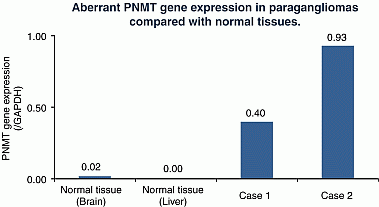ICEECE2012 Poster Presentations Endocrine tumours and neoplasia (112 abstracts)
Atypical paragangliomas responsible for adrenaline-dominant catecholamine secretion due to ectopic expression of phenylethanolamine-N-methyltransferase
K. Morimoto 1 , H. Shibata 1 , K. Miyashita 1 , I. Kurihara 1 , K. Bokuda 1 , A. Murai-Takeda 1 , Y. Mitsuishi 1 , Y. Motosugi 1 , R. Jo 1 , K. Isobe 2 , K. Takekoshi 2 & H. Itoh 1
University of Tsukuba, Tsukuba, Japan.
Introduction: Pheochromocytoma (PHEO) is a rare tumor of chromaffin cells with variable clinical presentation. Adrenal PHEOs secrete excessive amounts of noradrenaline or of noradrenaline plus adrenaline, whereas extra-adrenal PHEOs (paragangliomas) mostly secrete noradrenaline alone due to lack of expression of phenylethanolamine-N-methyltransferase (PNMT), the key enzyme converting noradrenaline into adrenaline. We report two exceptional cases of paragangliomas responsible for adrenaline-dominant catecholamine secretion.
Case Report: [Case 1] A 58-year-old man presented hypertension, hot flush, and dizziness. Computed tomography (CT) of the abdomen revealed right retroperitoneal tumor (25 mm in diameter) 1 year ago. He had been treated with nifedipine. CT also revealed gradual enlargement of the tumor (41 mm in diameter) during 2-year follow up. Endocrinological evaluation showed PHEO due to very high levels of 24-hour urine adrenaline (877.5 μg/day), noradrenaline (307.5 μg/day), metanephrine (4.6 mg/day), and normetanephrine (1.0 mg/day). [Case 2] A 74-year-old woman had presented resistant hypertension for 2 years and nocturnal transient hypertension attack for a few weeks. Endocrinological evaluation showed PHEO due to high levels of 24-hour urine adrenaline (109.6 μg/day), noradrenaline (214.7 μg/day), metanephrine (0.92 mg/day), and normetanephrine (0.56 mg/day). Magnetic resonance imaging (MRI) revealed right retroperitoneal mass (19 mm in diameter) beside inferior vena cava. The tumors were confirmed by 131I-MIBG scintigraphy in both cases. Laparoscopic tumorectomy was performed, and pathological findings indicated paragangliomas in both cases. The symptoms and the catecholamine excess diminished after surgery. Interestingly, quantitative RT-PCR analysis showed significant PNMT gene expression in both tumors.
Discussion: Atypical phenotypes of adrenaline-dominant catecholamine excess in two paraganglioma cases may be due to aberrant PNMT gene expression supposed to be induced by high local glucocorticoids levels adjacent to the adrenal glands and by other transcription factors.
Conclusion: We present 2 atypical cases of paragangliomas responsible for adrenaline-dominant catecholamine secretion.

Declaration of interest: The authors declare that there is no conflict of interest that could be perceived as prejudicing the impartiality of the research project.
Funding: This research did not receive any specific grant from any funding agency in the public, commercial or not-for-profit sector.




